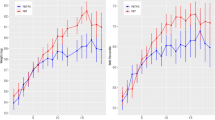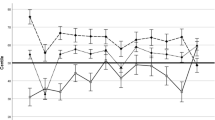Abstract
AIM: Eating disorders (ED) in children and younger adolescents are becoming more evident, but there is a small evidence base for their management in this population. We hypothesized that a new family-centered partial hospital program for young patients would be effective in promoting weight gain, as well as improvement in psychiatric symptoms. METHODS: A retrospective chart review of 56 patients treated in the program between August 2008 and November 2009 was performed. Historical data, anthropometric variables and scores from psychological instruments [Children’s Eating Attitudes Test (ChEAT), Children’s Depression Inventory (CDI), and Revised Children’s Manifest Anxiety Scale (RCMAS)] were collected on admission and at discharge. After exclusion, 30 patients were available for statistical analysis, using paired t-tests. The primary outcome variables were improvement in weight and change in total ChEAT score. Secondary outcomes included improvements in the CDI and RCMAS scores. Multivariate analysis included linear regression models that controlled for patient-specific fixed effects. RESULTS: The cohort was 87% female with a mean age of 12.8±2 years; 60% were diagnosed with ED not otherwise specified. Two-thirds had a co-morbid depressive and/or anxiety disorder. Change in weight was significant (p<0.0001), as were improvements on total ChEAT (p<0.0001), CDI (p=0.0002), and RCMAS (p<0.0001) scores. No historical factors were correlated with improvement, nor was use of psychotropic medications. Length of stay in weeks significantly predicted greater weight gain (p=0.004, R2=0.26). CONCLUSIONS: Patients treated in a family-centered partial hospital program had significant improvements in weight and psychological parameters. This approach holds significant promise for the management of young ED patients.
Similar content being viewed by others
References
Eisler I, Dare C, Russell GF, et al. Family and individual therapy in anorexia nervosa. A 5-year follow-up. Arch Gen Psychiatry 1997; 54: 1025–30.
Le Grange D, Binford R, Loeb KL. Manualized familybased treatment for anorexia nervosa: a case series. J Am Acad Child Adolesc Psychiatry 2005; 44: 41–6.
Lock J, le Grange D, Forsberg S, et al. Is family therapy useful for treating children with anorexia nervosa? Results of a case series. J Am Acad Child Adolesc Psychiatry 2006; 45: 1323–8.
Eisler I, Simic M, Russell GF, et al. A randomised controlled treatment trial of two forms of family therapy in adolescent anorexia nervosa: a five-year follow-up. J Child Psychol Psychiatry 2007; 48: 552–60.
Loeb KL, Walsh BT, Lock J, et al. Open trial of familybased treatment for full and partial anorexia nervosa in adolescence: evidence of successful dissemination. J Am Acad Child Adolesc Psychiatry 2007; 46: 792–800.
Le Grange D, Lock J, Loeb K, et al. Academy for Eating Disorders position paper: the role of the family in eating disorders. Int J Eat Disord 2010; 43: 1–5.
Golden NH, Katzman DK, Kreipe RE, et al. Eating disorders in adolescents: position paper of the Society for Adolescent Medicine. J Adolesc Health 2003; 33: 496–503.
Rome ES, Ammerman S, Rosen DS, et al. Children and adolescents with eating disorders: the state of the art. Pediatrics 2003; 111: e98–108.
Yager JDM, Halmi KA, Herzog DB, et al. Practice guideline for the treatment of patients with eating disorders. 3rd ed. Washington, DC, American Psychiatric Association, 2006.
Wiseman CV, Sunday SR, Klapper F, et al. Changing patterns of hospitalization in eating disorder patients. Int J Eat Disord 2001; 30: 69–74.
Treat TA, Gaskill JA, McCabe EB, et al. Short-term outcome of psychiatric inpatients with anorexia nervosa in the current care environment. Int J Eat Disord 2005; 38: 123–33.
Piran N, Kaplan A, Kerr A, et al. A day hospital program for anorexia nervosa and bulimia. Int J Eat Disord 1989; 8: 511–21.
Piran N, Langdon L, Kaplan A, et al. Evaluation of a day hospital program for eating disorders. Int J Eat Disord 1989; 8: 523–32.
Gerlinghoff M, Backmund H, Franzen U. Evaluation of a day treatment programme for eating disorders. Eur Eat Disord Rev 1998; 6: 96–106.
Zipfel S, Reas DL, Thornton C, et al. Day hospitalization programs for eating disorders: a systematic review of the literature. Int J Eat Disord 2002; 31: 105–17.
Fittig E, Jacobi C, Backmund H, et al. Effectiveness of day hospital treatment for anorexia nervosa and bulimia nervosa. Eur Eat Disord Rev 2008; 16: 341–51.
Willinge AC, Touyz SW, Thornton C. An evaluation of the effectiveness and short-term stability of an innovative Australian day patient programme for eating disorders. Eur Eat Disord Rev 2010; 18: 220–33.
Kong S. Day treatment programme for patients with eating disorders: randomized controlled trial. J Adv Nurs 2005; 51: 5–14.
Goldstein M, Peters L, Baillie A, et al. The effectiveness of a day program for the treatment of adolescent anorexia nervosa. Int J Eat Disord 2011; 44: 29–38.
American Psychiatric Association. Diagnostic and Statistical Manual of Mental Disorders. 4th Editon-Text Revision. Washington, DC, American Psychiatric Association, 2000.
National Center for Health Statistics. Height and Weight of Youths 12–17 Years, United States, Vital and Health Statistics. In: Vital and Health Statistics — Series 11–No. 124. Washington, DC, United States Government Printing Office, 1973.
Maloney MJ, McGuire JB, Daniels SR. Reliability testing of a children’s version of the Eating Attitude Test. J Am Acad Child Adolesc Psychiatry 1988; 27: 541–3.
Garner DM, Olmsted MP, Bohr Y, et al. The eating attitudes test: psychometric features and clinical correlates. Psychol Med 1982; 12: 871–8.
Kovacs M. Children’s Depression Inventory (CDI). New York, NY, Multi Health Systems, Inc., 1992.
Reynolds CR, Richmond BO. Revised Children’s Manifest Anxiety Scale (RSMAS) Manual. Los Angeles, CA, Western Psychological Services, 1985.
Fosson A, Knibbs J, Bryant-Waugh R, et al. Early onset anorexia nervosa. Arch Dis Child 1987; 62: 114–8.
Lask B, Bryant-Waugh R. Early-onset anorexia nervosa and related eating disorders. J Child Psychol Psychiatry 1992; 33: 281–300.
Lock J, Litt I. What predicts maintenance of weight for adolescents medically hospitalized for anorexia nervosa?. Eat Disord 2003; 11: 1–7.
Baran SA, Weltzin TE, Kaye WH. Low discharge weight and outcome in anorexia nervosa. Am J Psychiatry 1995; 152: 1070–2.
Howard WT, Evans KK, Quintero-Howard CV, et al. Predictors of success or failure of transition to day hospital treatment for inpatients with anorexia nervosa. Am J Psychiatry 1999; 156: 1697–702.
Nozoe S, Soejima Y, Yoshioka M, et al. Clinical features of patients with anorexia nervosa: assessment of factors influencing the duration of in-patient treatment. J Psychosom Res 1995; 39: 271–81.
Dancyger I, Fornari V, Schneider M, Fisher M, Frank S, Goodman B, et al. Adolescents and eating disorders: an examination of a day treatment program. Eat Weight Disord 2003; 8: 242–8.
Castro-Fornieles J, Casula V, Saura B, et al. Predictors of weight maintenance after hospital discharge in adolescent anorexia nervosa. Int J Eat Disord. 2007; 40: 129–35.
Steinhausen HC, Grigoroiu-Serbanescu M, Boyadjieva S, et al. The relevance of body weight in the mediumterm to long-term course of adolescent anorexia nervosa. Findings from a multisite study. Int J Eat Disord 2009; 42: 19–25.
Williamson DA, Thaw JM, Varnado-Sullivan PJ. Costeffectiveness analysis of a hospital-based cognitivebehavioral treatment program for eating disorders. Behav Ther 2001; 32: 459–77.
Gowers SG, Clark AF, Roberts C, et al. A randomised controlled multicentre trial of treatments for adolescent anorexia nervosa including assessment of costeffectiveness and patient acceptability — the TOuCAN trial. Health Technol Assess 2010; 14: 1–98.
Gowers SG, Weetman J, Shore A, et al. Impact of hospitalisation on the outcome of adolescent anorexia nervosa. Br J Psychiatry 2000; 176: 138–41.
Gowers SG, Clark A, Roberts C, et al. Clinical effectiveness of treatments for anorexia nervosa in adolescents: randomised controlled trial. Br J Psychiatry 2007; 191: 427–35.
Rosen DS. Eating disorders in children and young adolescents: etiology, classification, clinical features, and treatment. Adolesc Med 2003; 14: 49–59.
Author information
Authors and Affiliations
Corresponding author
Rights and permissions
About this article
Cite this article
Ornstein, R.M., Lane-Loney, S.E. & Hollenbeak, C.S. Clinical outcomes of a novel, family-centered partial hospitalization program for young patients with eating disorders. Eat Weight Disord 17, e170–e177 (2012). https://doi.org/10.1007/BF03325344
Received:
Accepted:
Published:
Issue Date:
DOI: https://doi.org/10.1007/BF03325344




